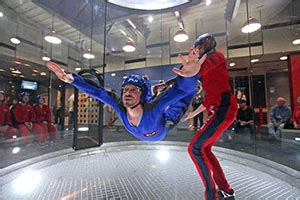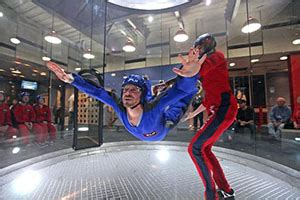Table of Contents
Curious about indoor skydiving but concerned about weight restrictions? Discover whether indoor skydiving has a weight limit and learn how it can vary at different locations. Find out how to enjoy the thrilling experience of indoor skydiving regardless of your weight.
Are you ready to experience the thrill of skydiving without having to jump out of a plane? Indoor skydiving is a popular activity that simulates the feeling of freefalling in a controlled environment. But before you strap on a suit and take the leap, it’s important to know if there are any weight restrictions. After all, you don’t want to show up at the indoor skydiving facility only to find out that you exceed the maximum weight limit. In this article, we will explore whether indoor skydiving has a weight limit and provide you with all the information you need to know before taking flight.
Introduction
Indoor skydiving has become a popular alternative to traditional outdoor skydiving, allowing individuals to experience the thrill of freefall in a controlled indoor environment. However, potential participants often wonder if there is a weight limit for indoor skydiving. In this article, we will explore whether or not indoor skydiving has a weight limit and provide some insights into this exciting activity.
Understanding Indoor Skydiving
Before delving into the weight limit aspect, it’s important to have a basic understanding of what indoor skydiving entails. Indoor skydiving involves using vertical wind tunnels that generate powerful updrafts, simulating the sensation of freefall. These wind tunnels create an environment where people can experience the feeling of skydiving without actually jumping from an airplane.
Physical Requirements
While indoor skydiving is generally accessible to a wide range of individuals, there are some physical requirements that participants must meet. These requirements mainly focus on safety and ensuring a positive experience for everyone involved. While weight is a consideration, it’s not the only factor taken into account.
Weight Limit
Many indoor skydiving facilities do have weight limits in place. The reason for this is primarily related to safety concerns and the ability to maintain control during the flight. The weight limit can vary depending on the facility and the type of wind tunnel being used. Generally, the weight limit for indoor skydiving ranges from around 250 to 300 pounds (113 to 136 kilograms).
Body Proportions
In addition to overall weight, body proportions can also play a role in determining whether an individual can participate in indoor skydiving. Facilities may have restrictions based on height, waist size, or other factors that can affect stability and control during the flight. It’s important to consult with the specific facility to understand their requirements.
Safety Considerations
The weight limit for indoor skydiving is primarily in place to ensure the safety of participants. Exceeding the weight limit can potentially compromise the ability to maintain stability and control during the flight, increasing the risk of injury. By adhering to weight limits, facilities aim to create a safe and enjoyable experience for all individuals involved.
Consulting the Facility
If you are interested in indoor skydiving but are concerned about the weight limit, it is advisable to contact the facility directly. They will be able to provide you with specific information regarding their weight restrictions and any other requirements they may have. This will help you determine if you meet the criteria and can partake in indoor skydiving.
Alternatives and Modifications
If you find that you exceed the weight limit for indoor skydiving, there are alternative options available. Some facilities offer modified experiences for individuals who are unable to participate in traditional indoor skydiving. These modifications can include reduced wind speeds or additional safety measures to accommodate different body types.
Embracing Inclusivity
While weight limits may be disappointing for some individuals, it’s important to remember that safety is the top priority for indoor skydiving facilities. By implementing weight restrictions, they can ensure a safer experience for everyone involved. It’s crucial to embrace inclusivity and work towards maintaining a balance between accessibility and safety in this thrilling activity.
Conclusion
Indoor skydiving is an exhilarating activity that provides individuals with the opportunity to experience the thrill of freefall in a controlled environment. While weight limits do exist in many indoor skydiving facilities, they are in place to prioritize safety and maintain control during the flight. If you are interested in indoor skydiving, consult the specific facility for their weight restrictions and alternative options if necessary. Remember, safety is paramount, and embracing inclusivity ensures a positive experience for all participants.
Does Indoor Skydiving Have a Weight Limit?
Welcome to our guide on indoor skydiving weight limits. In this article, we will provide you with important information about weight restrictions for indoor skydiving. Please read through these instructions carefully to ensure a safe and enjoyable experience.
1. Importance of Understanding Weight Restrictions:
It is crucial to understand the weight limits imposed by indoor skydiving facilities, as they are put in place to ensure the safety of all participants. By adhering to these restrictions, you can minimize the risk of injury and optimize your overall experience.
– Indoor Skydiving Facility Guidelines:
Indoor skydiving facilities have their specific weight limits determined by various factors, including the size and strength of their wind tunnels. Failure to comply with these guidelines may result in denial of entry or cancellation of your reservation.
– Communicate with the Facility:
When booking an indoor skydiving session, be sure to communicate your weight accurately. This will allow the facility to make appropriate arrangements and ensure your safety during the experience. Honesty is paramount in preserving your well-being.
– Health Considerations:
In some cases, health conditions or limitations may affect weight limits set by indoor skydiving facilities. It is essential to consult with a medical professional if you have any concerns or pre-existing conditions that may impact your participation in indoor skydiving.
2. Maximum Weight Limits:
Each indoor skydiving facility may have different maximum weight restrictions. Typically, the maximum weight allowed can range between 250-300 pounds (113-136 kilograms). Exceeding this weight limit may compromise the stability and safety of the wind tunnel, putting both the participant and instructor at risk.
– Maintaining Equilibrium:
Indoor skydiving relies on aerodynamics, so maintaining equilibrium is important for safety reasons. Participants above the maximum weight limit may experience difficulties in maintaining stability in the wind tunnel and might negatively impact the experience for others as well.
– Equipment Limitations:
The equipment used in indoor skydiving, such as jumpsuits and safety gear, is designed to accommodate specific weight ranges. Exceeding these limits may compromise the effectiveness and functionality of the equipment, compromising the participant’s safety.
– Group Bookings:
If you are planning a group booking for indoor skydiving, ensure that all participants fall within the weight restrictions. This will facilitate a smoother and more enjoyable experience for everyone involved.
3. Consultation and Fitness Considerations:
Before participating in indoor skydiving, it is advisable to consult with a physician, especially if you have concerns about your fitness level or any underlying health conditions which may limit your ability to safely engage in the activity.
– Body Mass Index (BMI):
While weight is a primary consideration, facilities may also take into account your body mass index (BMI) as a measure of your overall fitness level and suitability for indoor skydiving. It is recommended to have a BMI within the healthy range for optimal participation.
– Physical Fitness Requirements:
Indoor skydiving can be physically demanding, requiring participants to maintain specific body positions and perform various movements. It is essential to be aware of your personal fitness level and limitations to ensure a safe and enjoyable experience.
– Safety First:
Ultimately, the weight limits set by indoor skydiving facilities prioritize the safety and well-being of all participants. It is important to respect these restrictions and work towards achieving a healthy weight and fitness level to enhance your participation in this exhilarating activity.
Conclusion:
Indoor skydiving weight limits are in place to protect participants and ensure a safe and unforgettable experience. By understanding and adhering to these guidelines, you can fully enjoy the thrill of indoor skydiving while prioritizing your safety. If you have any specific concerns or inquiries about weight limits, please contact the indoor skydiving facility directly for accurate and up-to-date information. Happy flying!
Does Indoor Skydiving Have A Weight Limit?
Point of view: Instructional
When it comes to the exhilarating experience of indoor skydiving, many people wonder if there is a weight limit. In this guide, we will provide you with all the necessary information regarding the weight restrictions for indoor skydiving.
- Understanding weight limits:
- Indoor skydiving facilities have weight limits in place to ensure the safety of participants and maintain the proper functioning of their equipment.
- These weight limits are determined based on various factors, including the design of the wind tunnel and the capabilities of the air flow system.
- Tunnel-specific weight limits:
- Each indoor skydiving facility may have its own specific weight limit.
- Typically, these weight limits range from around 250 pounds (113 kilograms) to 300 pounds (136 kilograms).
- It is essential to check with the specific facility you plan to visit to determine their exact weight limit.
- Body shape considerations:
- In addition to weight, body shape and size can also affect your ability to participate in indoor skydiving.
- Some facilities may have additional guidelines or restrictions based on factors such as height and waist size.
- It is important to carefully review the guidelines provided by the facility to ensure you meet all the necessary criteria.
- Consulting with the facility:
- If you are unsure whether you meet the weight requirements for indoor skydiving, it is recommended to contact the facility directly.
- They will be able to provide you with accurate information and address any concerns or questions you may have.
- Remember, the weight limits are in place to prioritize safety and ensure an enjoyable experience for all participants.
- Alternative options:
- If you exceed the weight limit for indoor skydiving, you may still have other options available.
- Some facilities offer specialized programs or arrangements for individuals who fall outside the standard weight range.
- Contact the facility to inquire about alternative options or activities that may be suitable for you.
In conclusion, indoor skydiving does have weight limits to ensure the safety and optimal functioning of the wind tunnel. It is crucial to check with the specific facility you plan to visit for their exact weight limit and any additional guidelines based on body shape. If you have any doubts or concerns, it is always best to consult directly with the facility to explore alternative options if needed. Enjoy the thrilling experience of indoor skydiving within the specified weight limits and have a fantastic time!
Thank you for taking the time to visit our blog and read about the weight limit for indoor skydiving. We hope that this article has provided you with valuable information and answered any questions you may have had regarding this topic. If you are considering trying indoor skydiving or have been curious about it, knowing the weight limit is crucial for a safe and enjoyable experience.
Indoor skydiving is an exhilarating activity that allows individuals to experience the thrill of skydiving in a controlled and safe environment. Unlike traditional skydiving, which involves jumping out of an airplane, indoor skydiving takes place in a vertical wind tunnel. This powerful column of air allows participants to experience the sensation of freefalling without the need for an actual parachute. It is a fun and exciting activity that is suitable for people of all ages and fitness levels.
However, it is important to note that indoor skydiving does have a weight limit. The weight limit is in place to ensure the safety of both the participant and the instructors. The wind speeds in the tunnel are adjusted based on the weight of the individual, and exceeding the weight limit can affect the stability and control of the flight. It is crucial to follow the weight restrictions set by the facility to ensure a safe and enjoyable experience for everyone involved.
In conclusion, if you are considering indoor skydiving, it is essential to be aware of the weight limit. This limit is in place to maintain the safety and integrity of the activity. By following the weight restrictions set by the facility, you can ensure a safe and enjoyable experience. Indoor skydiving is a thrilling adventure that offers a unique opportunity to experience the sensation of freefalling. Whether you are a seasoned adrenaline junkie or someone looking for a new and exciting experience, indoor skydiving is definitely worth a try. So, why not give it a go and defy gravity in a safe and controlled environment?
Thank you once again for visiting our blog, and we hope to see you soon at an indoor skydiving facility near you!
Video Does Indoor Skydiving Have A Weight Limit
Here are some common questions that people ask about the weight limit for indoor skydiving:
-
What is the weight limit for indoor skydiving?
Indoor skydiving facilities usually have weight restrictions in place to ensure safety. The weight limit can vary depending on the specific facility, but it typically ranges between 250 to 300 pounds (113 to 136 kilograms). It’s important to check with the facility you plan to visit for their specific weight restrictions.
-
Can overweight or obese individuals participate in indoor skydiving?
While weight limits exist for safety reasons, indoor skydiving can still be enjoyed by individuals who are overweight or obese, as long as they fall within the designated weight limit of the facility. It’s crucial to follow the guidelines provided by the facility in order to ensure a safe and enjoyable experience.
-
Are there any additional requirements for heavier participants?
In certain cases, indoor skydiving facilities may have additional requirements or considerations for participants who are closer to the maximum weight limit. This can include being able to maintain a stable body position during flight or having a higher level of physical fitness. It’s advisable to contact the facility beforehand to discuss any specific concerns or requirements.
-
What should I do if I exceed the weight limit for indoor skydiving?
If you exceed the weight limit set by the facility, it’s recommended to explore alternative skydiving options that can accommodate higher weights. Outdoor skydiving centers often have different weight restrictions and equipment that can handle greater loads. Research local skydiving centers or consult with professionals in the field to find suitable alternatives.
-
Can children participate in indoor skydiving?
Most indoor skydiving facilities have age restrictions in place, typically requiring participants to be at least three years old or older. However, weight limits may still apply, especially for younger children. It’s essential to check with the facility regarding their specific age and weight requirements for child participants.
Remember to always consult the individual facility for their precise weight limits and regulations, as they may vary. Safety should be the primary concern when participating in any kind of skydiving activity.






